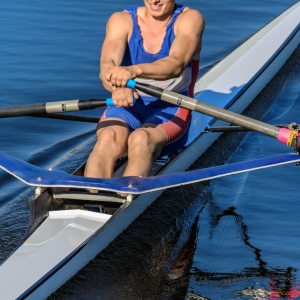Rowing Tips to Stay Safe this Summer While Enjoying the Water
 During the warmer months, getting out on the water can be a fun and exciting recreational activity. Among the many water sports, rowing is a versatile, low-impact activity that almost anyone can enjoy. It can be done competitively, for enjoyment, on a team, or individually. Plus, it’s a great way to involve many different muscle groups and get a full-body workout.
During the warmer months, getting out on the water can be a fun and exciting recreational activity. Among the many water sports, rowing is a versatile, low-impact activity that almost anyone can enjoy. It can be done competitively, for enjoyment, on a team, or individually. Plus, it’s a great way to involve many different muscle groups and get a full-body workout.
Wondering if rowing is the right sport for you? Jim Peters, PT, DPT, Orthopaedic Hospital of Wisconsin physical therapist, discusses rowing, the benefits, and his tips for preventing a rowing-related injury.
Benefits of Rowing
 Rowing is a recreational or competitive sport that involves the leg muscles at the start of the stroke to help move one or two oars through the water. It is accomplished on a sliding seat to get the most efficient stroke and potential boat speed. Like paddling, it also uses the arms to pull the oar through the water. However, a special move called “feathering” helps get the blade out of the water and smoothly returns it to the starting position.
Rowing is a recreational or competitive sport that involves the leg muscles at the start of the stroke to help move one or two oars through the water. It is accomplished on a sliding seat to get the most efficient stroke and potential boat speed. Like paddling, it also uses the arms to pull the oar through the water. However, a special move called “feathering” helps get the blade out of the water and smoothly returns it to the starting position.
The benefits of rowing can be both physical and collaborative. There are ways to row either alone or with a team, outdoors or indoors. You can find motivating indoor challenges to complete on ergometers (“ergs”). An entire online community of rowers log their meters and motivate one another on discussion boards. Additionally, there are outlets for on-water training and competition either as a team or individually through local rowing clubs. Finally, there exists the simple pleasure of exploring or touring a long stretch of river or lake at your own pace.
There are opportunities for middle school through older adult participation in the sport, and it is possible to participate in the sport year-round. Rowing is a total body workout and is considered a low-impact sport. The movement involves a limited impact on your joints, so anyone interested in exploring this type of fitness or sport is welcome to try and see how it could fit into their routine.
Rowing and Injury
Rowing injuries are initially due to the novelty of the sport–gripping hard on the oar handle and pulling into your body. You could develop blisters on your hands that can develop into calluses, but if you begin slowly, the tenderness is minimal.
Depending on the type of injury a rower sustains, it would be crucial to know if it were due to overuse of a body part used during the stroke or a one-time accident due to a mishap. Communication with a coach if on a team would be a pivotal part of the recovery process to return to practice.
Injury Prevention Tips
It is crucial to seek guidance from a coach at a rowing club, local group, or online videos to prevent an injury. The early lessons from an expert will guide you in the right direction and allow you to perform your workouts and focus on your fitness goals with efficient and safe techniques.
Rowing Resources
- Milwaukee Rowing Club
- CrossFit | Rowing
- Group Fitness Class & HIIT Workouts | Orangetheory Fitness US
- Indoor Rowing Machine Technique – How to use Concept2 Rowers
You can improve your muscle strength, endurance, and power to perform the stroke to the best of your ability. In rowing, that looks like doing squats or deadlifts, stiff-legged deadlifts, bent-over rows, and any abdominal exercises. Each of these will condition your muscles and grip strength needed for the stroke.
Further, you can condition your body to be ready for particular postures that efficient rowing requires. Yoga postures such as child’s pose and half boat pose can serve you well in this regard. Stretching your wrists, back, and legs can prepare you for or help you cool down from a workout.
If an orthopedic injury or condition is holding you back from trying out recreational activities like rowing, make an appointment with our skilled orthopedic specialists today. They can create a plan to help you feel your best and ready for any endeavor.

